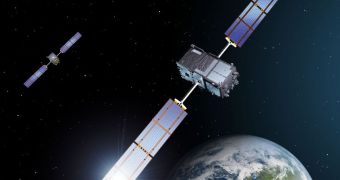Experts at the European Space Agency (ESA) say that Galileo In-Orbit Validation Element (GIOVE) test satellites will soon begin to act as radiation monitors in space. The goal is to protect the upcoming Galileo satellite navigation satellite network from the harshness of space weather.
This is becoming increasingly important at this point, because the Sun is nearing a peak in its solar maximum, a period in its 11-year cycle when sunspot activity is at a maximum. During maximum, the star releases massive amounts of radiation.
Charged particles released during flares or coronal mass ejections (CME) can batter our planet, threatening to melt electrical equipment, damage power grids, and dry satellites in space. When you're building a network of 30+ high-tech satellites, that's the last thing you what happening to you.
This is why ESA is planning to use the GIOVE spacecraft for radiation monitoring. If experts know that a blast of solar radiation will hit ahead of time, then they can take measures to protect the satellites from the onslaught.
“The frequency of solar storms varies with the 11-year solar cycle, reflected by the amount of sunspots visible. Right now we are in the upwards phase, with maximum solar activity predicted between 2012 and 2014,” ESA Galileo project engineer Stefano Binda explains.
“This is an issue of concern for all satellites and therefore also for Galileo, as we begin launching this October and are scheduled to begin operations by mid-2014, right in the heart of the ‘solar max’,” the official goes on to say.
Satellites orbiting in low-Earth orbit, at altitudes of just a couple hundred miles from the planetary surface, are relatively protected from solar radiation by the geomagnetic field the Earth is generating.
But the Galileo spacecraft will fly at altitudes of about 23,200 kilometers, where these natural defense mechanisms will not protect them to any significant extent. Furthermore, Galileo components will navigate through Earth's outer Van Allen radiation belt at all times.
“Propagating through an energized ionosphere leads to signal delay. Ordinary telecommunication systems can just boost through broadcast energy but satellite navigation uses the signal delay to calculate the user’s position,” Binda explains.
“Just a billionth of a second’s delay can cause a 30[-centimeter] error, and the ionosphere can cause errors in the order of several meters” in Galileo's data output, he adds. But the GIOVE vehicles could point at these distortions, allowing ESA to measure and compensate for them in the data.
“GIOVE-A carries two different radiation monitors – the UK-designed Merlin and French CEDEX, while GIOVE-B carries a single ESA-designed Standard Radiation Environment Monitor. They maintain a count of the particles hitting them,” the expert says.

 14 DAY TRIAL //
14 DAY TRIAL //